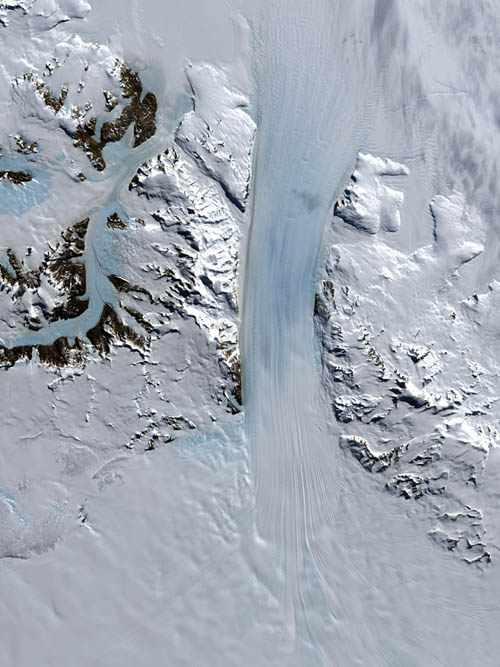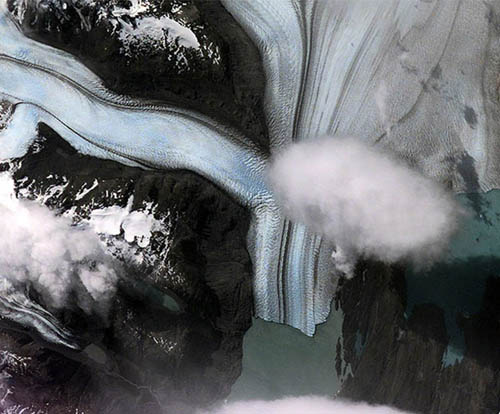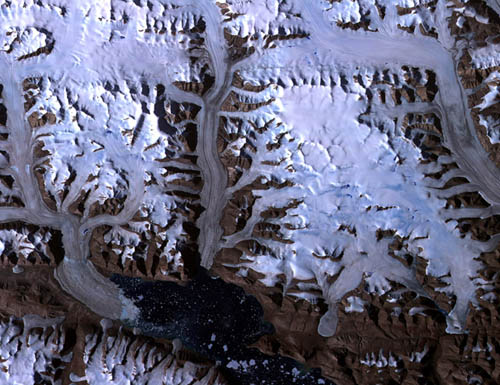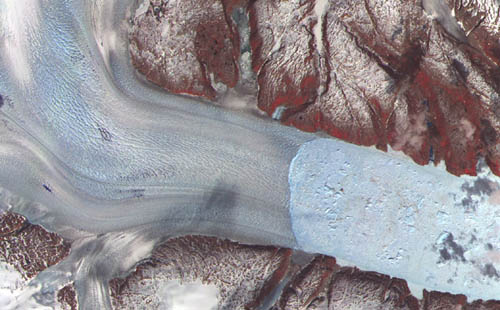Artificial Glaciers 101
 [Image: From Wired Science's photo gallery, "Stunning Views of Glaciers Seen From Space"].
[Image: From Wired Science's photo gallery, "Stunning Views of Glaciers Seen From Space"].In light of this week's ongoing conversation, I thought I'd take a quick look at how to build a glacier.
The "art of glacier growing," as New Scientist calls it, is "also known as glacial grafting." It has been "practiced for centuries in the mountains of the Hindu Kush and Karakorum ranges," and it was never about science fiction: "It was developed as a way to improve water supplies to villages in valleys where glacial meltwater tended to run out before the end of the growing season."
The artificial glacier, then, is simply a traditional landscape-architectural technique that manipulates and amplifies pre-existing natural processes. It is vernacular hydrology writ large.
 [Image: From Wired Science's photo gallery, "Stunning Views of Glaciers Seen From Space"].
[Image: From Wired Science's photo gallery, "Stunning Views of Glaciers Seen From Space"].So how do you build an artificial glacier?
First, you need a site, and that site should be mountainous; altitudes higher than 4,500 meters are thermally preferable. From New Scientist:
- Once the site is selected, ice is brought to rocky areas where there are small boulders about 25 centimeters across. The rocks protect the ice from sunlight, and often have ice trapped in the gaps between them. This seems to be critical to a successful "planting."
- After [glacier-growing mountain villagers] have added female to the male ice (traditionally by importing 12 man-loads or about 300 kilograms of the stuff), they cover the area with charcoal, sawdust, wheat husk, nutshells or pieces of cloth to insulate it. Gourds of water placed among the ice and rocks are also critical to a glacier’s chances of forming, according to [artificial-glacier expert, Ingvar Tveiten]. As the glacier grows and squeezes the gourds, they burst, spreading water on the surrounding ice, which then freezes.
- Any snowmelt trapped in the budding glacier also freezes, adding more ice. Pockets of cold air moving between the rocks and ice keep the glacier cool. When the mass of rock and ice is heavy enough, it begins to creep downhill, forming a self-sustaining glacier within four years or so.
Let me repeat that: to call these artificial glaciers is a poetic over-statement, as they are much more realistically described as artificially maintained deposits of snow—what I have elsewhere called non-electrical ice reserves. But the thermally self-sustaining nature of these deposits nonetheless makes them susceptible to glaciological analysis.

 [Image: From Wired Science's photo gallery, "Stunning Views of Glaciers Seen From Space"].
[Image: From Wired Science's photo gallery, "Stunning Views of Glaciers Seen From Space"].But there are also other, equally lo-fi techniques of glacier-growing.
Elsewhere, we read that "a good artificial glacier costs $50,000," even though "the materials are simple: dirt, pipes, rocks—and runoff from real glaciers high above." Importantly, then, but quite obviously, a controlled act of artificial glaciation can only be achieved in regions where there is already water available; you can't simply snap your fingers and "build a glacier" in a Tucson parking lot.
In any case, this second technique "is remarkably simple":
- Water from an existing stream is diverted using iron pipes to a comparably shady part of the valley and here the water is allowed to flow out onto an inclined mountainside. At regular intervals along the slope of the mountain, small embankments of stone are made which impede the flow of water making shallow pools. At the start of winter, water is allowed to flow into this `masonry contraption' and as the winter temperatures are constantly falling the water freezes forming a thick sheet of ice looking almost like a thin, long glacier.
All this is done before the onset of winter. During the winter, as temperatures fall steadily, the water collected in the small pools freezes. Once this cycle has been repeated over many weeks, a thick sheet of ice forms, resembling a long, thin glacier.
After all, glaciers are very long events, as mammoth memorably put it.
 [Image: From Wired Science's photo gallery, "Stunning Views of Glaciers Seen From Space"].
[Image: From Wired Science's photo gallery, "Stunning Views of Glaciers Seen From Space"].To reiterate the simplicity of this latter design process, I want to quote artificial-glacier expert Chawang Norphel, from an interview he did with the IPS:
- Glacier melt at different altitudes is diverted to the shaded side of the hill, facing the north, where the winter sun is blocked by a ridge or a mountain slope. At the start of winter (November), the diverted water is made to flow onto the sloping hill face through appropriately designed distribution channels or outlets.
At regular intervals stone embankments are built, which impede the flow of water, making shallow pools. In the distributing chambers, 1.5-inch diameter G pipes are installed after every five feet for proper distribution of water.
Water flows in small quantities and at low velocity through the G pipes, and freezes instantly. The process of ice formation continues for three to four winter months and a huge reserve of ice accumulates on the mountain slope, aptly termed “artificial glacier.”
We're not talking about nuclear-powered snow-blowers built and operated by Darth Vader, in other words; we're talking about rural Himalayan villagers who have learned to reorganize their region's existing snowpack so as to make it thermally self-sustaining.
Or, as Norphel himself phrases it, "Apart from solving the irrigation problem, the artificial glaciers help in the recharging of ground water and rejuvenation of springs. They enable farmers to harvest two crops in a year, help in developing pastures for cattle rearing and reducing water sharing disputes among the farmers."
 [Image: From Wired Science's photo gallery, "Stunning Views of Glaciers Seen From Space"].
[Image: From Wired Science's photo gallery, "Stunning Views of Glaciers Seen From Space"].Having said that, the design possibilities become truly amazing when you scale this up, from a vernacular aid project to the level of carefully-maintained industrial infrastructure, and when you consider a wide range of alternative reasons for stockpiling ice (and, of course, things go bonkers if you let yourself consider genuinely and deliberately sci-fi-inflected ideas, such as maintaining artificial glaciers at the lunar south pole or using artificial glaciation as a Martian terraforming technique).
In any and all cases here, this makes artificial glaciers a fascinating topic for an architectural design studio—at least in my opinion—and the resulting conversations (and even open disagreements) about this topic have been very much worth the time already.
#glacierislandstorm





Comments are moderated.
If it's not spam, it will appear here shortly!
Fascinating! I would love to see photos of the village or Western artificial glaciers, if you can find any.
I found this article on a thread at permies.com where we were discussing water storage in alpine drylands, and the idea of deliberately creating stored ice sounds very practical from where I live. I think it's just calling it a 'glacier' that feels like stretching a point.
Here's that thread if anyone's interested: http://www.permies.com/t/33750/podcast/Podcast-Geoff-Lawton-Part#265160
Post a Comment